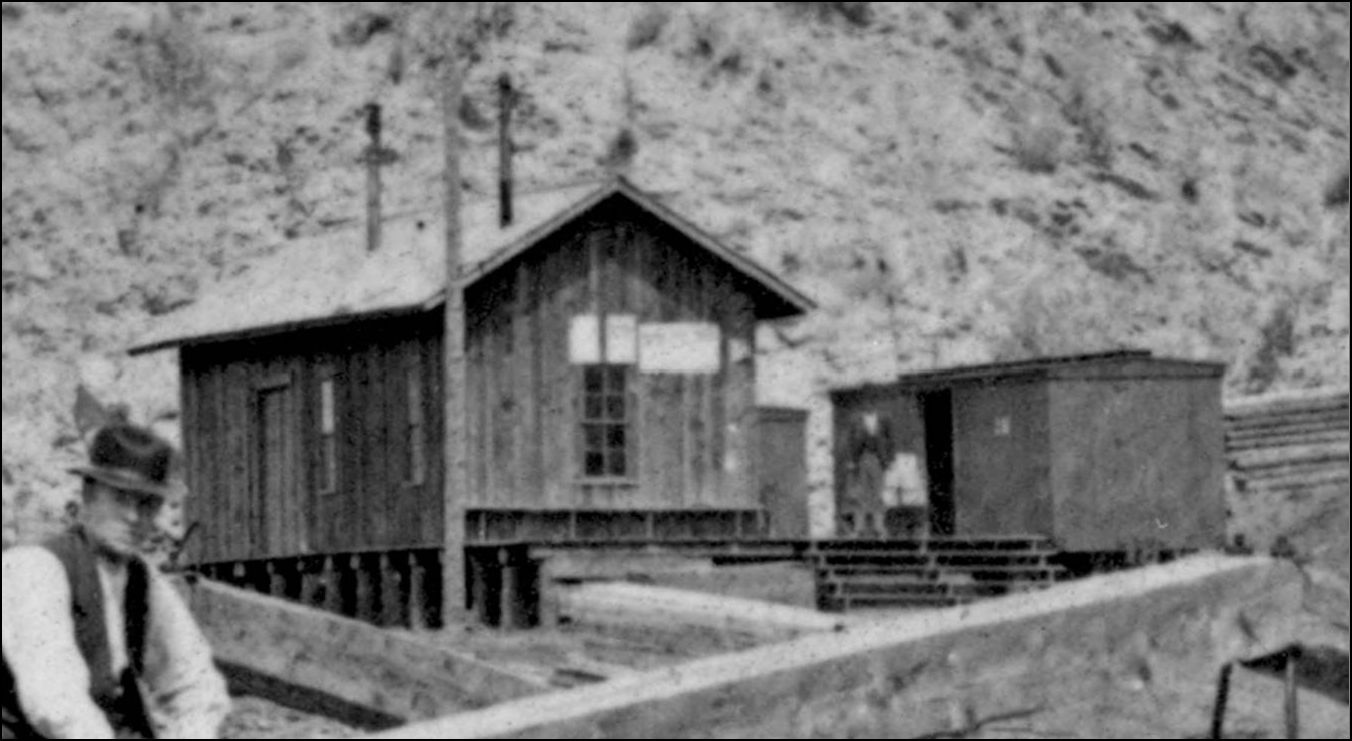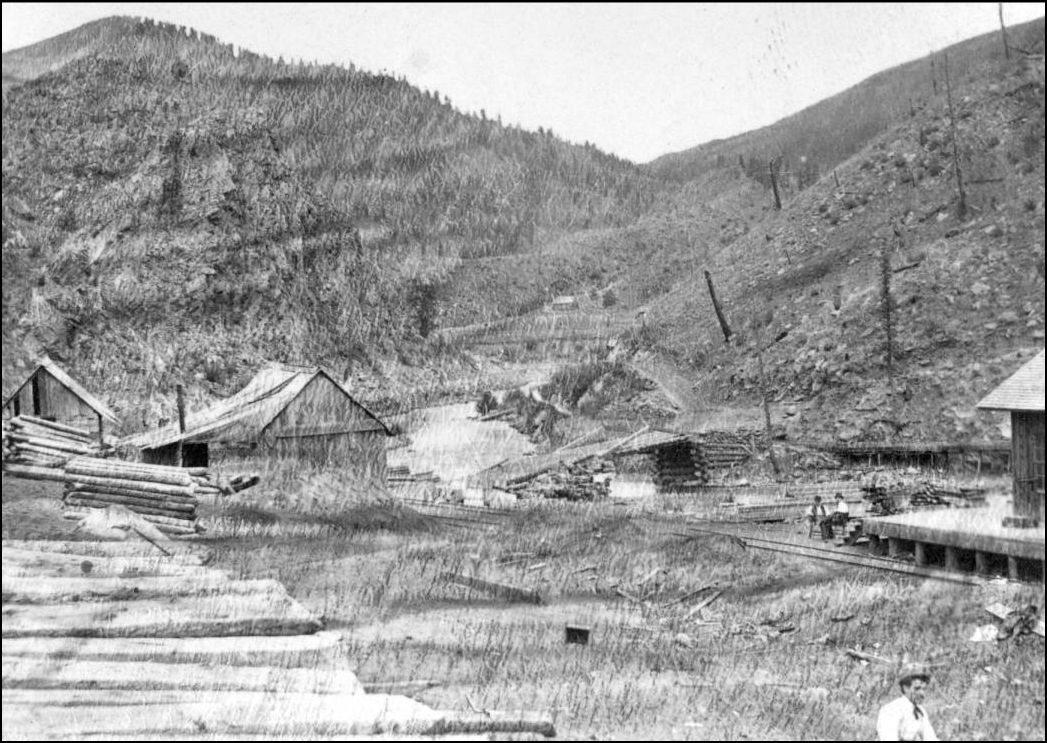Floyd Hill: The Early Years.
|
This post was updated on .
By golly Chris, the building in the third photo, with the Block lettered C&S Box car. The building to the left of it looks like a caboose that looks like it was built from Derrell Poole's mystery caboose.
Rick |
Re: Floyd Hill: The Early Years.
|
Looks like a MOW car made from a boxcar
|
Re: Floyd Hill: The Early Years.
|
It also looks like it was on the ground
|
|
Anyone else notice the crazy guy hanging from the pole at lower left ?

"Duty above all else except Honor"
|
Re: Floyd Hill: The Early Years.
|
Not until you mentioned it.What about the guy in the box?
|
Floyd Hill: The Early Years-Plus One More.
|
This post was updated on .
Lachlan McLean Photo
 FWIW: the original Bridge is at the rear, still intact. This was the Sign admonishing the hooligans not to speed over the old bridge haha! 
UpSideDownC
in New Zealand |
Re: Floyd Hill: The Early Years-Plus One More.
|
And earlier years...
This is from a stereo view that says it's at end of track. The little wooden bridge in the lower-left looks to be in the same spot as the steel truss bridge in Chris Walker's latest photo. 
|
Re: Floyd Hill: The Early Years-Plus One More.
|
There's another view taken that same day from the same point by the same photographer. It's found in the Colorado Central book by Abbott, et al. The freight cars were moved around between the two photos and the engine turned and placed at the opposite end of the train. The passenger cars remain in the same orientation in both photos.
I've presumed these photos pre-date operation (or tracks) into Idaho Springs and some questions quickly come up: The original passing siding in front of the station in earlier photos appears removed in these photos, with a slight hint of where the ties had been marking the location. Was it moved to the mainline realignment cut into the hill, just beyond the buildings on the right edge, but closer to the new bridges? I can't make one out. Alternately, what looks like a switchstand just past the freight shed or leaning on the shed door of the building where the lime car is parked had me wondering if a track ran behind the station. None is discernable. But there clearly had to be a passing track somewhere, the engine moves from one end to the other of the passenger cars in the two photos. What about the turntable the engine turned on? There is a reference (one) in a newspaper during the Idaho Springs extension construction of the turntable being moved to Idaho--a very vague reference that could be read several ways. Chasing this I wondered if the logical turntable location would be up by the curve of the line towards the bridge. If so, it can't be made out. But there is a structure, partially hidden by the buildings on the upper left edge of the photos, at the end of the siding that runs past the platform and towards Clear Creek. It looks like a gallows/truss structure and there even looks to be a ring rail. Strange location, not easily accessible and subject to flooding. But what is it otherwise? Or, are these from after the line to Idaho had opened and reflect a change in the infrastructure and use of tracks. I'm less convinced of that but without concrete evidence...
Dave Eggleston
Seattle, WA |
Re: Floyd Hill: The Early Years-Plus One More.
|
Or, are these from after the line to Idaho had opened and reflect a change in the infrastructure and use of tracks.
Dave, my take is just that. Note in the Colorado Central Rail Road book, the passing track photos are dated 24th Feb, 1873, and the Loco is one of the Saddle-tankers. I'd say the pictures of the two-Car Passenger were taken after they got track to Idaho.
UpSideDownC
in New Zealand |
Re: Floyd Hill: The Early Years-Plus One More.
|
Chris, I see where you're coming from. A few things keep a possible earlier date open for me.
Those saddle tanks were being removed and tenders added about 3-4 years prior to the line being completed into Idaho Springs. Nesmith stacks were being installed maybe as early as 1875 (my notes are packed away so I could be way off here). Grading on the extension was reported in May 1876 but then little discussion of it. It then takes off in March 1877. By May 23rd only two miles of rail had been laid. Rails finally reached Idaho in July. The photos clearly show a new mainline cut into the hill and the existence of the bridges--which leads me to place these photos to no earlier than mid-1876 but more likely Spring 1877. The volume of business seen at Floyd Hill indicates it still is an important freight/teaming terminus, which may also hint at the pre-Idaho-in-operation period. But, it's equally arguable that we're seeing a photo immediately after the line opened to Idaho, the siding's removal may be a critical clue and what we're actually seeing is a lingering traffic momentum at Floyd Hill until the teamsters all made the switch to Idaho. It seems Floyd Hill's importance dropped off quickly after trains were running to Idaho Springs. Maybe someone can shed light on the truth of that. So, with the uncertainty, I have to hold with an open mid-1876 - mid-1878 timeframe. I wish we had access to hi-res versions of both pictures. Here's that very vague turntable reference--from the June 20 1877 Colorado Transcript. I know I'm on shaky ground here, and only started wondering if that turntable was at Floyd Hill and then moved to Idaho Springs based on two things: 1) once the engines were given tenders circa 1875 there's an argument to having them turned for the trip back to Forks Creek, as was done at Black Hawk and 2) that turntable-looking structure by the creek in these two photos. Nothing conclusive, just breadcrumbs to follow the question to a hopeful answer (an I'm not hopeful one will turn up). And maybe, just maybe the turntable reference is an error in reporting. 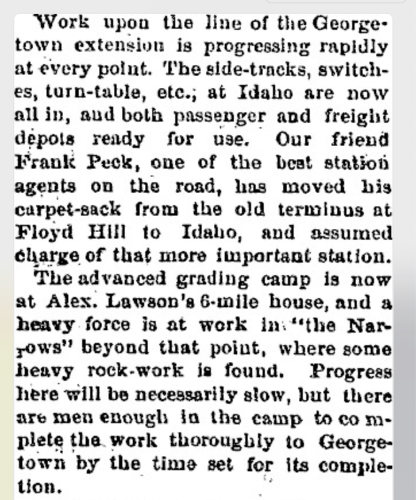
Dave Eggleston
Seattle, WA |
Re: Floyd Hill: The Early Years-Plus One More.
|
Good input Dave,
 given that; just how much freight hauled up the C.C. to Floyd Hill(transferred there to Freighters) for Leadville was there at that period, and just where had the DSP&P reached at that same time? That could be a factor in Floyd Hill remaining open for sometime longer as a transfer point. As for accuracy in Newspaper reporting on the actual nitty-gritty details, hmmmm.... 
I've recently come across something that was innocently captured in a photo of a major event, covered extensively(but not detailed) by several local Newspapers at the time(and not mentioned in the usual Books either), yet actual specifics relating to the detail in the Image was not covered specifically, just lightly touched upon, in a manor suggesting the Reporter(s) weren't actually there. I'm still hunting for more on this anomally, to which I'll add my Ten Cents, soon. 
UpSideDownC
in New Zealand |
Re: Floyd Hill: The Early Years-Plus One More.
I learned that lesson long ago. But a reference to a turntable is, even if questionable (and this definitely is), something of note. It triggered a search and had I not spotted that hint of a turntable-looking structure it would've died. That structure is not confirmable, not deniable--just simply a curiosity that could be... Damn I hate that but hopefully something will surface, like a better resolution version of those pictures.
Dave Eggleston
Seattle, WA |
Re: Floyd Hill to Idaho Springs in 1877.
|
Dave,
I came across your clipping referencing the Turn-Table and also another referencing a Y.  It sounded like to me that(in both cases) the Reporter was musing on what he thought would be built for RR facitities at Idaho, neither bearing any remblance to what was constructed. In the case of a Y, then the formation would have showed up in later images, and same with a siding area with this turntable. Keep in mind they were grading around Downieville(Mill City) by that time and G'town wasn't far enough away to require either turning methods constructed at Idaho. Do you have a book pg, image or link to the Photo that you see the turntable structure in? I've stared at Idaho photos so many times now and you have my interest piqued, or maybe, I'm just missing something obvious!
UpSideDownC
in New Zealand |
Re: Floyd Hill to Idaho Springs in 1877.
|
This post was updated on .
Chris,
No argument that this could be musing on the reporter's part. But barring any solid evidence all I can say is "I dunno." Was there a temporary install for dealing with end-of-track during construction, much like possibly happened at Webster, and possibly at Alpine (later Fisher). I actually have two images, both amazingly taken on the same day. One is in the Abbott/McCoy Colorado Central book. My copy is packed away so I don't have the page number but an image I took of the page a year ago, and have circled the structure: 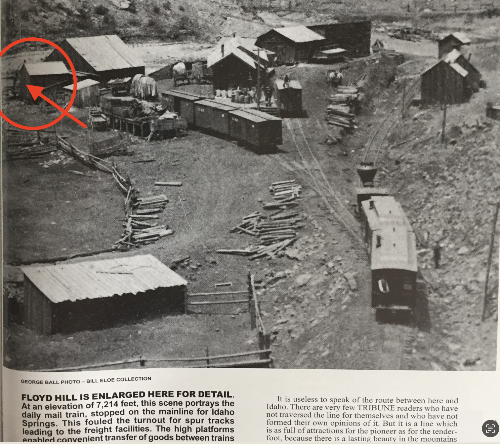 Visible in the full size image in the book are the possible turntable superstructure supports and also ring rail with wheel behind that small warehouse upper right. It just so happens a second picture was taken that day, which someone had spotted on ebay and posted above in this thread. First the full photo:  Here is a blow-up of the structure hidden behind the shed:  The location seems susceptible to washout--my original thought for a turntable location was near the curve entering the bridging. Access to the structure circled seems operationally restricted by being at the end of a loading spur. But there are many such (what we'd consider operationally restricted) points to be found on railroads in the 1870s. The two photos have me scratching my head. Turntable? Stiff leg derrick? Structure for a cable-way or ferry? Interestingly, the engine was turned between these two photos, in one photo pointing to Idaho, in the other pointing to Forks. This was part of why I started looking for a turntable at Floyd Hill after reading the newspaper reference. Part of this thinking is also related to the fact that all the same cars, and only the same cars, both freight and passenger, are in the photo, though not in the same spots. There's been some switching; nothing has been picked up nor dropped off elsewhere between the photos. The same people, too, some in the same places, including a chap sitting on top of a boxcar in both photos. It just feels like the engine was turned at this location. But feeling isn't fact... Further complicating things is the complete lack of a visible passing siding. The one that had been in front of the station appears to have been removed--wagon ruts are seen where rails once sat. Perhaps one is out of sight near the bridge. The grading and at least one pony truss bridge are in the background. The right of way has been realigned away from the station to properly accommodate the curve to the crossing. Is this during early construction towards Idaho or is it after service was established to that point? I can't say. They were doing work on the extension a good time prior to the rails going in. Bonus in both photos: a lime car.
Dave Eggleston
Seattle, WA |
|
This post was updated on .
Dave!!
You're darn right tooting that's a Turntable. I had to rack my brain right out of its socket for this one. Exactly the same design as found at Morrison, on the D.S.P.&P. around the same time period. Funny that, Eh!   Aparrently this photo turns out the earliest there; nothing more than a run-around pair of tracks and no sidings, etc. I had thought it was later. DPL X-8461  There was a short time period that the Stage met the C.C.RR at Masonville(later Sawmill Gulch) below Idaho proper. 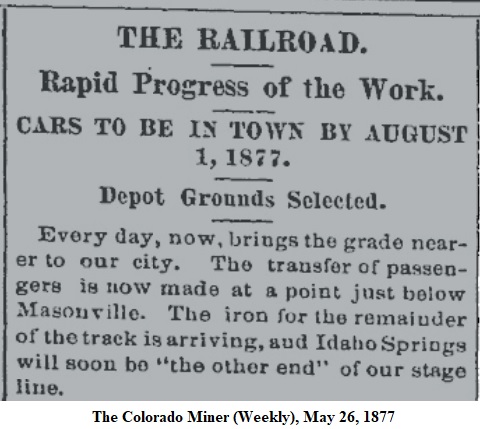
UpSideDownC
in New Zealand |
Re: Floyd Hill Turntable 1877.
|
This post was updated on .
It sure does have similarities to the Morrison table--thanks for making that connection. Too bad we don't have a more detailed view of it.
If this really was a turntable, was it moved to Idaho, per the article, once the line opened to that point? And what about Georgetown: The earliest map of Georgetown I've seen, the 1878 Willits map in the DPL collection, only shows a wye. So what became of that turntable? Out on a limb: Did Central City get a turntable for a short period in the early 1880s as was discussed as a possible thing in the papers? Or was it stored somewhere and possibly moved to some location on the UP later? Any clues? That photo of the bridge definitely is early, but there are at least three other very early photos of Floyd Hill. The first, DPL X-8460, was taken from the opposite viewpoint of the bridge photo and taken the same day: Note the two gents sitting by the platform are the same two seen in the photo of the bridge. The new mainline grade seen in the two later photos ran approximately where the fellow in the foreground is standing. 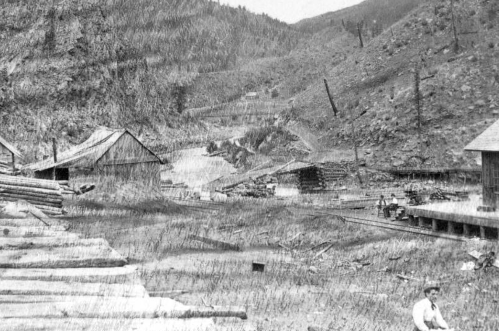 Two further images in Abbot's Colorado Central Book may be even earlier, showing not only the east end passing switch but also that its switchstand was on the opposite side of the track from what we see in the later photos. Best seen in the book, I only have a photo of the pages: 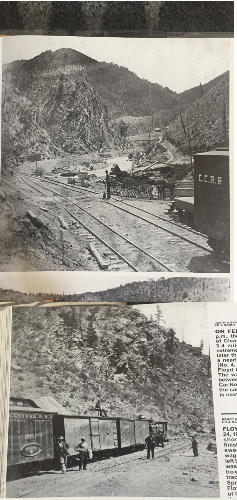
Dave Eggleston
Seattle, WA |
«
Return to C&Sng Discussion Forum
|
1 view|%1 views
| Free forum by Nabble | Edit this page |


